Kiss Me, Kill Me and Other True Cases Read online
Page 9
The homicide investigators continued to check residents in an ever-widening circle with Heidi’s house in the center. They found men with records for sexual crimes and younger men whose answers to their questions didn’t quite add up. They had a suspect in mind, but they could never link him to Heidi’s murder.
One of the things detectives count on is that even the most secretive murderer usually has to tell someone, either to brag about what he has done or because he feels guilty and is compelled to talk. Allegedly, Heidi Peterson’s killer told the woman in his life, and when they broke up, she told someone else. Eventually, word reached Seattle detectives. They were sure they knew the killer’s name.
They looked beneath a house where the suspect said he had left evidence, but too much time had passed. It was gone. They could not arrest him.
Heidi’s case is a classic example of a case closed “Exceptional.” But someday the person who killed her will pay for the horrendous crime against her. One way or the other.
• • •
Through the seventies, eighties, and nineties, forensic science leapt ahead and techniques were developed that even expert criminalists could never have imagined: computerized fingerprint systems, hair and fiber identification, scanning electron microscopes, spectrometers with laser probes, surveillance cameras that were almost infinitesimal, and—probably the biggest boon to detectives in a century or more—DNA. Other than identical twins, each human being in the world has his or her own DNA profile, detectible in body fluids, bones, the tags (roots) of hairs.
And DNA would revolutionize homicide investigation.
Fittingly, as the world moved on to another century, the Seattle Police Department initiated a speciality “squad,” although it was made up of only two detectives: Richard Gagnon and Gregg Mixsell. It would be known as the “Cold Case” squad. They would concentrate on cases long unsolved, some of them in dusty files, some almost lost in the past because even those closest to the victim were dead, and the murderer himself—or herself—might also be deceased. The original investigators were gone, too, in many cases. And, predictably, more recent cases grabbed the headlines and the public’s interest. Gagnon and Mixsell began poring over the old cases. In some instances, there were no police files on them any longer, and they found the details in the King County prosecutor’s paperwork.
Gradually, the two investigators became as familiar with many of the unavenged victims as the detectives who initially worked the cases. Luckily, they discovered that some of those investigators had preserved physical evidence that had been virtually useless decades before—hoping that there would be scientific advances where the fingerprints, bloodstains, and body fluids might be the one key to solve a murder case.
The comparison of DNA profiles was first used to find and convict a killer in the mid-eighties. But it took a substantial amount of the sampler to make that comparison, and often the test matter itself was destroyed in the DNA process.
Still, it was a whole new way to catch a killer. The FBI got AFIS (Automated Fingerprint Identification System) operational nationwide about the same time. With only one fingerprint—and not all ten that had been required before that—the computers could spit out the name of a suspect who had left that print at the scene of a crime. Before, human beings had studied the ridges, loops, and whorls of the prints submitted.
Out of the almost three hundred unsolved murders in the annals of crime history in Seattle, some will never be solved. But many long since written off as cold as death itself will be. Gregg Mixsell and Dick Gagnon began to get results. By 2004, after only three years, they had solved twenty of those homicides.
The newest DNA tests use a process known as STRPCR (short tandem repeat polymerase chain reaction) requiring only minuscule amounts of the test material. As many seminars as I have attended on DNA, I still can’t explain exactly how it works—I got a D in most of the science courses I took in high school and college. However, it does work. Our DNA profile is the blueprint of who we are.
Seattle’s Cold Case Squad had more success with homicides that involved a sexual attack because semen is the most likely body fluid a killer leaves on his victim. Because rape is sometimes the motive behind murder, Gagnon and Mixsell had a plethora of cases to reexamine.
17
As several cold case squads began to get results in the Northwest, I was surprised that some of my own long-held theories on suspects had been wrong. I wasn’t alone.
In 1988, the Thurston County Sheriff’s Office detectives took another look at the murder case on a young woman that would go unsolved for twenty-eight years.
After her sister saw television coverage of the then unidentified victim in December 1973, she recognized the clothing she had worn. It was Katherine Merry Devine, who had last been seen hitchhiking north of the University District in Seattle on the Sunday after Thanksgiving—November 25. She was only 14 years old, but she could pass for 18. She was slender and had long brown hair parted in the middle. Like many teenagers, Katherine Merry had had an argument with her mother about dating, and took off to visit relatives on the Oregon coast, more than two hundred miles south of where she was last seen.
Two friends had seen her accepting a ride with a man driving a small white pickup truck, and she had waved to them as the truck pulled away. Invariably, Kathy called home to let her family know that she had arrived safely and that she was sorry for leaving in a huff. But this time she didn’t. Her parents, Sally and Bill Devine, reported her as a runaway.
Eleven days later—on Thursday, December 6—a worker picking up trash in the Margaret McKenny Campground near Olympia, Washington, came across her body in a depression in the forest floor next to Campground Space #1. The campground was close to the I-5 freeway and about sixty miles from Seattle.
A week after that, I got a phone call from the then sheriff of Thurston County, Don Redmond. Because I had written several articles about Thurston County homicide cases and he knew that I had once been a police officer, he asked me if I would attend a briefing with him and his top detectives, Dwight Caron and Paul Barclift, about the Devine case. As a “special deputy,” I would also look at the files on this fresh case and view slides of the crime scene. Redmond wanted my take on the investigation, but more than that he needed a comprehensive summary of the case—at least thirty pages of narrative. Time was of the essence, or so it seemed in mid-December 1973.
None of us could have realized just how long it would be before this case would be solved.
Sheriff Redmond said he would have a deputy pick up my finished document on Sunday afternoon so that he could present it to the Thurston County prosecutor.
The winter of 1973–1974 was unseasonably warm, and Kathy’s body had decomposed more rapidly than one might expect in December. She had been found lying facedown in the forest undergrowth of ferns, salal, moss, and a low meandering shrub Native Americans call kinnickinik. Kathy was fully clothed in blue jeans, a white peasant blouse, a mock suede coat with fur trim, “waffle stomper” boots, and some costume jewelry.
But her jeans had been slit from waist to crotch down the back seam, indicating that her assailant had probably had a sharp knife. However, small animals had ravaged her corpse, entering at her neck. That suggested that Kathy had either been strangled or had her throat cut because damaged tissue decomposes more rapidly than skin with no trauma. A postmortem wasn’t very satisfactory; her heart, lungs, and liver had been carried away by animals. However, investigators Caron and Barclift asked the pathologist to take a vaginal swab so that semen found in her body could be preserved. Considering the era, that in itself was almost miraculous.
The timing of Kathy’s murder and the places where she had last been seen and where her body was found would make one man highly suspect: Ted Bundy.
For almost thirty years, I believed that Katherine Merry Devine was one of Ted’s victims, and pondered the synchronicity of that weekend in December 1973. As most readers know, Bundy was my partner at Se
attle’s Crisis Clinic in 1972, and I spent two nights a week alone with him as we answered calls from people in deep emotional distress—people who were considering suicide. On Saturday night, December 15, 1973, I attended a Crisis Clinic Christmas party, and I spent most of the evening talking to Ted Bundy. He was, at that point, a fair-haired boy in the Republican party, assistant to the Washington State party chairman, and he had been active in helping Dan Evans’s successful election campaign for governor. Everybody liked Ted.
I was no more likely to consider him as a murder suspect than I would Santa Claus himself.
When a man named “Ted” surfaced as the prime suspect in the serial murders of perhaps a dozen young women in the Northwest in early 1974, forensic psychiatrists and psychologists took educated guesses about what he would be like.
Although no one thought he was really named Ted, and that that was only a name he had given to prospective victims, Dr. Richard Jarvis drew a verbal picture of “Ted.” Ironically, Jarvis compared the still unknown “Ted” killer to John Canaday—although he didn’t use Canaday’s name. “He is probably between 25 and 35, mentally ill in a sense, but not the type who will draw attention to himself,” Jarvis told reporters. “The man I’m thinking of is currently serving life in prison. He changed after his longtime high school girlfriend rejected him. He married someone else later, but he began his sexual prowlings after his wife filed for divorce. Like ‘Ted,’ he is not legally insane, but he is a sexual psychopath, with no deficiency in intelligence, no brain damage, and no frank psychosis.”
John Canaday was safely in prison, but Ted Bundy was still free and hiding behind a perfect mask when Kathy Devine was murdered.
We know now that Bundy was not what he seemed to be. It has been documented for decades that Ted Bundy’s trail of serial murders began in the winter of 1973–74. On January 4, 1974, Bundy left one girl for dead after a savage sexual attack, and then moved on to take the lives of eight young women before he moved to Utah in the summer of 1974.
During this time, he was either attending the University of Puget Sound about thirty miles south of Seattle on I-5, or working for the Washington State Department of Emergency Services in Olympia. He lived within two miles of where Kathy Devine was last seen and he regularly drove I-5 between north Seattle and Olympia. While Ted drove a tan Volkswagen “bug,” his brother was said to own a white pickup truck.
There seemed to be too many coincidences not to believe that Ted Bundy had picked up the hitchhiking Kathy Devine, raped and killed her, and left her body in an isolated area as he allegedly did his other Northwest victims, one of whom was a coed in Olympia.
Although Bundy was executed in Florida on January 24, 1989, Kathy Devine’s murder was not one of those he admitted to committing. Even so, many people who had studied Bundy’s crimes for many years—including myself—were convinced that it was he who had killed her. Even her parents believed that Ted Bundy had murdered Kathy. Only Paul Barclift suspected a local man, whose family suffered an unusual number of suspicious fires.
Cold case detectives, a new crew of Thurston County sheriff’s detectives, and DNA proved me wrong. It had been twenty-eight years since Kathy Devine’s death when Thurston County Sheriff Gary Edwards announced on March 8, 2002, that she was not one of Bundy’s victims after all. Rather, DNA test comparisons of a vaginal swab taken from Kathy and a blood sample from a convict at the federal prison on McNeil Island, Washington, matched.
William E. Cosden Jr., now 57, was found not guilty by reason of insanity in the rape slaying of a young woman in Maryland in 1967. Deemed sane, he was released four years later. He moved to Washington State, where he worked at a truck stop owned by his father. It was near an I-5 off-ramp in Tumwater, just south of Olympia, and the truck stop was a popular place for hitchhikers.
Kathy Devine hadn’t been murdered by the man who gave her a ride in Seattle. She almost certainly reached Olympia safely, hopping out at the truck stop, where she hoped to catch another ride south to Portland.
A witness with a long memory belatedly told Thurston County investigators that he recalled Cosden’s having dark reddish-brown stains on his shirt on the morning of November 26, 1973. Another observer said that he had seen what appeared to be bloodstains in Cosden’s truck.
Coincidentally, his truck caught fire at midnight on the twenty-sixth and was completely destroyed. Except for Barclift and Dwight Caron, Cosden had escaped scrutiny by detectives for a while, but he was arrested on rape charges involving another woman in 1976 and sentenced to thirty-two years in prison. That didn’t mean real time, however, and he stood a chance of being paroled as early as 1990, but he was not a cooperative inmate. His temper got him tossed out of two pre-release housing units and he was returned to more secure facilities.
In 1986, Detective Mark Curtis of Thurston County obtained a court order and took a blood sample from Cosden. State-of-the-art DNA testing wasn’t yet precise enough to risk losing the precious swab sample taken from Kathy Devine, and investigators forced themselves to wait. And Cosden apparently forgot all about having had his blood drawn.
But he would be reminded. Curtis was offered some grant money through the Washington State Attorney General’s HITS program, and in 1988 he was able to pay for DNA testing. As he, Caron, and Barclift suspected, the DNA on the swab was a likely match to connect Katherine Devine to William Cosden. They didn’t want to use all the sampler, however, for fear of losing that vital piece of evidence.
Detectives Joe Vukich and Brian Schoening visited Cosden at the federal prison on McNeil Island. He was adamant that he didn’t know anything about Kathy Devine, had never even seen her, and that there was no way he could be connected to her.
But the Thurston County Sheriff’s Office didn’t give up. In 2002 there was no question at all that the DNA left by Kathy Devine’s killer belonged to Cosden. Detectives David Haller and Tim Rudolf confronted Cosden again. There was no arguing with DNA results, and he now recalled having sexual relations with her, but insisted that he had not killed her. His denials didn’t help Cosden, not when the circumstantial evidence of the blood on his clothes and his truck fire the day after Kathy vanished were weighed. Arrested in prison, Cosden was furious that he was being charged with Kathy Devine’s murder.
William Cosden remains in prison. He has failed to convince the Indeterminate Sentence Review Board that he is a likely candidate for rehabilitation, particularly after they read a disjointed, pornographic “essay” he wrote in his cell. And, of course, because of the new information they learned about Cosden’s deadly connection to the 14-year-old runaway whose murder had been a tragic mystery since a foggy, rainy night in November 1973.
The slight indentation in the forest floor where Kathy was left is still there, more than thirty years later. Dwight Caron has retired, and Paul Barclift passed away shortly after his “bulldoggedness” came to successful fruition with Cosden’s arrest. Mark Curtis will retire in a little more than a year.
18
The murder of Katherine Merry Devine appeared to be the oldest unsolved case to be closed in Washington State. But the investigation into Sandy Bowman’s death predated Kathy’s murder by five years. With every positive DNA match between long-dead victims and suspects who had been free to move about in society when Sandy died, there was always the question “Could this have been the one who killed her?”
In 1975, Seattle police investigators tackled another homicide that was as baffling as Sandy’s. It was April 30 when a noontime jogger found the body of a dark-haired woman lying faceup in blackberry brambles beneath the I-5 freeway near the Roy Street exit. The first officers responding saw that she wore a gray, yellow, and pink striped dress and a lightweight tan coat. Her panties were missing, and one leg of her pantyhose had been sliced away by something very sharp—a knife or a razor. The other leg of her pantyhose with the attached panty section had been pulled down over her left leg inside out so that her stacked-heel black sandal was still caught ins
ide.
Detective Sergeant Bruce Edmonds and detectives Don Strunk and Benny DePalmo weren’t even aware of the perfect spring day as they stared down at the dead woman. The sight before them was too graphic and too sad. Even in death, they could see that she had been classically attractive, with clear gray eyes and thick chestnut hair parted in the middle and pulled back into a single thick braid that wound two feet down her back.
Someone had stabbed her viciously in her abdomen and her back, and on both sides of her torso, cutting right through her clothing in many instances. The detectives had no help at all with clues that might identify the dead woman. She looked to be in her mid-twenties, possibly as old as 30. But she had no purse, there were no labels in her dress or coat, and she wore no jewelry. All they knew about her at the beginning of their investigation was that she had certainly been dead for more than a dozen hours.
Rigor mortis had frozen her body completely, and the lividity that occurs after death when the heart ceases to pump blood through veins and arteries appeared as purplish striations along the front of her corpse. She had to have lain facedown somewhere for many hours before she was left on her back as she was found.
The dead woman was immaculately clean, right down to her unpolished fingernails. She wore little if any makeup. She was just over five feet nine inches tall, and weighed 148 pounds. She would have been able to put up a good fight, and she obviously had: her arms bore many defense wounds.
The King County medical examiner, Dr. Patrick Besant-Matthews, pointed out that the knife that had pierced the unknown victim’s liver, stomach, lungs, and the main artery of her body—the aorta—had been fairly small. But she had been stabbed eleven times with a blade somewhere between two and a half to three inches long. There was even a wound below her right knee. Her murderer must have been in a frenzy; it was the kind of violence found after an attack by a sexual sadist or by someone who hated his victim with seething anger.

 Too Late to Say Goodbye: A True Story of Murder and Betrayal
Too Late to Say Goodbye: A True Story of Murder and Betrayal Green River, Running Red
Green River, Running Red Bitter Harvest
Bitter Harvest Dead by Sunset: Perfect Husband, Perfect Killer?
Dead by Sunset: Perfect Husband, Perfect Killer? Lust Killer
Lust Killer And Never Let Her Go: Thomas Capano: The Deadly Seducer
And Never Let Her Go: Thomas Capano: The Deadly Seducer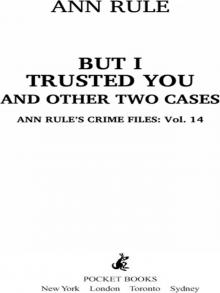 But I Trusted You and Other True Cases
But I Trusted You and Other True Cases Smoke, Mirrors, and Murder and Other True Cases
Smoke, Mirrors, and Murder and Other True Cases If You Really Loved Me
If You Really Loved Me Kiss Me, Kill Me and Other True Cases
Kiss Me, Kill Me and Other True Cases Fatal Friends, Deadly Neighbors and Other True Cases
Fatal Friends, Deadly Neighbors and Other True Cases Practice to Deceive
Practice to Deceive Mortal Danger and Other True Cases
Mortal Danger and Other True Cases Without Pity: Ann Rule's Most Dangerous Killers
Without Pity: Ann Rule's Most Dangerous Killers Everything She Ever Wanted
Everything She Ever Wanted A Fever in the Heart and Other True Cases
A Fever in the Heart and Other True Cases In the Still of the Night
In the Still of the Night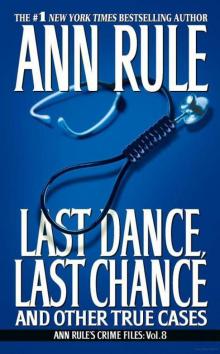 LAST DANCE, LAST CHANCE - and Other True Cases
LAST DANCE, LAST CHANCE - and Other True Cases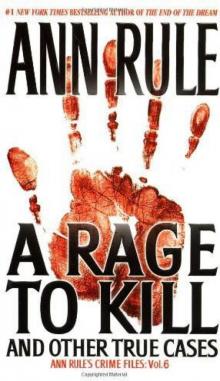 A Rage to Kill
A Rage to Kill The I-5 Killer
The I-5 Killer The Stranger Beside Me
The Stranger Beside Me Everything She Ever Wanted: A True Story of Obsessive Love, Murder, and Betrayal
Everything She Ever Wanted: A True Story of Obsessive Love, Murder, and Betrayal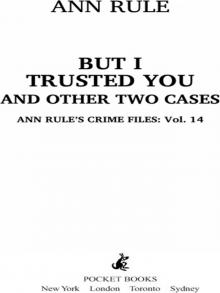 But I Trusted You
But I Trusted You Without Pity
Without Pity Kiss Me, Kill Me
Kiss Me, Kill Me Too Late to Say Goodbye
Too Late to Say Goodbye Lying in Wait
Lying in Wait Fatal Friends, Deadly Neighbors
Fatal Friends, Deadly Neighbors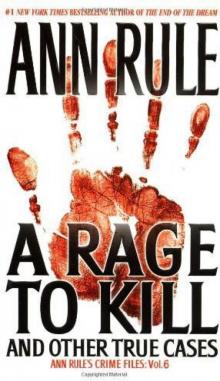 A Rage to Kill: And Other True Cases
A Rage to Kill: And Other True Cases And Never Let Her Go
And Never Let Her Go Lying in Wait Ann Rule's Crime Files Vol.17
Lying in Wait Ann Rule's Crime Files Vol.17 Blood Secrets: Chronicles of a Crime Scene Reconstructionist
Blood Secrets: Chronicles of a Crime Scene Reconstructionist No Regrets
No Regrets Mortal Danger
Mortal Danger But I Trusted You: Ann Rule's Crime Files #14
But I Trusted You: Ann Rule's Crime Files #14 Empty Promises
Empty Promises Dead by Sunset
Dead by Sunset Last Dance, Last Chance
Last Dance, Last Chance Don't Look Behind You
Don't Look Behind You